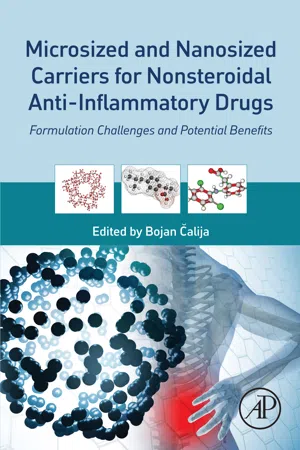
Microsized and Nanosized Carriers for Nonsteroidal Anti-Inflammatory Drugs
Formulation Challenges and Potential Benefits
- 284 pages
- English
- ePUB (mobile friendly)
- Available on iOS & Android
Microsized and Nanosized Carriers for Nonsteroidal Anti-Inflammatory Drugs
Formulation Challenges and Potential Benefits
About This Book
Microsized and Nanosized Carriers for Nonsteroidal Anti-Inflammatory Drugs: Formulation Challenges and Potential Benefits provides a unique and complete overview of novel formulation strategies for improvement of the delivery of NSAIDs via encapsulation in microsized and nanosized carriers composed of different materials of natural and synthetic origin.
This book presents the latest research on advances and limitations of both microsized and nanosized drug carriers and NSAIDs before discussing the formulation aspects of these drug carriers that are intended for oral, dermal, and transdermal administration of NSAIDs.
In addition, functionality of these materials as potential excipients for microsized and nanosized carriers is discussed and debated. Practical solutions for improving effectiveness of these drugs are included throughout the book, making this an important resource for graduate students, professors, and researchers in the pharmaceutical sciences.
- Covers a wide range of microsized and nanosized carriers in one resource, including particulate carriers (microparticles, nanoparticles, and zeolites) and the soft colloidal carriers, such as micro-emulsions and nano-emulsions
- Presents the reader with various formulation approaches dependent on the characteristics of the material, model drug, and desired route of administration
- Approaches are based on the latest research in the area and formulation strategies may have broader applications to the encapsulation of other active pharmaceutical ingredients
Frequently asked questions
Information
Clinical Uses of Nonsteroidal Anti-Inflammatory Drugs (NSAIDs) and Potential Benefits of NSAIDs Modified-Release Preparations
Abstract
Keywords
1.1. Nonsteroidal anti-inflammatory drugs
Table of contents
- Cover
- Title page
- Table of Contents
- Copyright
- List of Contributors
- Editor Biography
- Preface
- Chapter 1: Clinical Uses of Nonsteroidal Anti-Inflammatory Drugs (NSAIDs) and Potential Benefits of NSAIDs Modified-Release Preparations
- Chapter 2: Polymeric Microparticles and Inorganic Micro/Nanoparticulate Drug Carriers: An Overview and Pharmaceutical Application
- Chapter 3: Microemulsions and Nanoemulsions as Carriers for Delivery of NSAIDs
- Chapter 4: Diversity and Functionality of Excipients for Micro/Nanosized Drug Carriers
- Chapter 5: Influence of Polycation Functional Properties on Polyanion Micro/Nanoparticles for NSAIDs Reinforced Via Polyelectrolyte Complexation: Alginate–Chitosan Case Study
- Chapter 6: PLA-Based Nanoparticulate Drug Carriers as a Percutaneous Delivery System for Ketoprofen
- Chapter 7: Natural Surfactants-Based Micro/Nanoemulsion Systems for NSAIDs—Practical Formulation Approach, Physicochemical and Biopharmaceutical Characteristics/Performances
- Chapter 8: Natural and Modified Silica-Based Materials as Carriers for NSAIDs
- Index